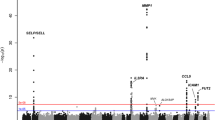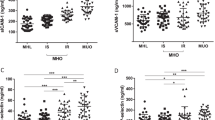Abstract
Circulating soluble adhesion molecules have been suggested as useful markers to predict several clinical conditions such as atherosclerosis, type 2 diabetes, obesity, and hypertension. To determine genetic factors influencing plasma levels of soluble vascular cell adhesion molecule-1 (VCAM-1) and P-selectin, quantitative trait locus (QTL) analysis was performed on an intercross between C57BL/6J (B6) and C3H/HeJ (C3H) mouse strains deficient in apolipoprotein E-deficient (apoE−/−). Female F2 mice were fed a western diet for 12 weeks. One significant QTL, named sVcam1 (71 cM, LOD 3.9), on chromosome 9 and three suggestive QTLs on chromosomes 5, 13 and 15 were identified to affect soluble VCAM-1 levels. Soluble P-selectin levels were controlled by one significant QTL, named sSelp1 (8.5 cM, LOD 3.4), on chromosome 16 and two suggestive QTLs on chromosomes 10 and 13. Both adhesion molecules showed significant or an apparent trend of correlations with body weight, total cholesterol, and LDL/VLDL cholesterol levels in the F2 population. These results indicate that plasma VCAM-1 and P-selectin levels are complex traits regulated by multiple genes, and this regulation is conferred, at least partially, by acting on body weight and lipid metabolism in hyperlipidemic apoE−/− mice.






Similar content being viewed by others
References
Abe Y, El-Masri B, Kimball KT, Pownall H, Reilly CF, Osmundsen K, Smith CW, Ballantyne CM (1998) Soluble cell adhesion molecules in hypertriglyceridemia and potential significance on monocyte adhesion. Arterioscler Thromb Vasc Biol 18:723–731
Abiola O, Angel JM, Avner P, Bachmanov AA, Belknap JK, Bennett B, Blankenhorn EP, Blizard DA, Bolivar V et al (2003) The nature and identification of quantitative trait loci: a community’s view. Nat Rev Genet 4:911–916
Allen S, Khan S, Al-Mohanna F, Batten P, Yacoub M (1998) Native low density lipoprotein-induced calcium transients trigger VCAM-1 and E-selectin expression in cultured human vascular endothelial cells. J Clin Invest 101:1064–1075
Blankenberg S, Barbaux S, Tiret L (2003) Adhesion molecules and atherosclerosis. Atherosclerosis 170:191–203
Blann AD, Tse W, Maxwell SJ, Waite MA (1994) Increased levels of the soluble adhesion molecule E-selectin in essential hypertension. J Hypertens 12:925–928
Blann AD, Seigneur M, Steiner M, Miller JP, McCollum CN (1998) Circulating ICAM-1 and VCAM-1 in peripheral artery disease and hypercholesterolaemia: relationship to the location of atherosclerotic disease, smoking, and in the prediction of adverse events. Thromb Haemost 79:1080–1085
Buemi M, Allegra A, Aloisi C, Corica F, Alonci A, Ruello A, Montalto G, Frisina N (1997) Cold pressor test raises serum concentrations of ICAM-1, VCAM-1, and E-selectin in normotensive and hypertensive patients. Hypertension 30:845–847
Chen NG, Holmes M, Reaven GM (1999) Relationship between insulin resistance, soluble adhesion molecules, and mononuclear cell binding in healthy volunteers. J Clin Endocrinol Metab 84:3485–3489
Chironi G, Dosquet C, Del-Pino M, Denarie N, Megnien JL, Drouet L, Bal dit Sollier C, Levenson J, Simon A (2006) Relationship of circulating biomarkers of inflammation and hemostasis with preclinical atherosclerotic burden in nonsmoking hypercholesterolemic men. Am J Hypertens 19:1025–1031
Cybulsky MI, Iiyama K, Li H, Zhu S, Chen M, Iiyama M, Davis V, Gutierrez-Ramos JC, Connelly PW, Milstone DS (2001) A major role for VCAM-1, but not ICAM-1, in early atherosclerosis. J Clin Invest 107:1255–1262
De Caterina R, Ghiadoni L, Taddei S, Virdis A, Almerigogna F, Basta G, Lazzerini G, Bernini W, Salvetti A (2001) Soluble E-selectin in essential hypertension: a correlate of vascular structural changes. Am J Hypertens 14:259–266
De Pergola G, Pannacciulli N, Coviello M, Scarangella A, Di Roma P, Caringella M, Venneri MT, Quaranta M, Giorgino R (2008) sP-selectin plasma levels in obesity: association with insulin resistance and related metabolic and prothrombotic factors. Nutr Metab Cardiovasc Dis 18:227–232
DeSouza CA, Dengel DR, Macko RF, Cox K, Seals DR (1997) Elevated levels of circulating cell adhesion molecules in uncomplicated essential hypertension. Am J Hypertens 10:1335–1341
Ferri C, Desideri G, Valenti M, Bellini C, Pasin M, Santucci A, De Mattia G (1999) Early upregulation of endothelial adhesion molecules in obese hypertensive men. Hypertension 34:568–573
Gearing AJ, Newman W (1993) Circulating adhesion molecules in disease. Immunol Today 14:506–512
Hackman A, Abe Y, Insull W Jr, Pownall H, Smith L, Dunn K, Gotto AM Jr, Ballantyne CM (1996) Levels of soluble cell adhesion molecules in patients with dyslipidemia. Circulation 93:1334–1338
Hak AE, Pols HA, Stehouwer CD, Meijer J, Kiliaan AJ, Hofman A, Breteler MM, Witteman JC (2001) Markers of inflammation and cellular adhesion molecules in relation to insulin resistance in nondiabetic elderly: the rotterdam study. J Clin Endocrinol Metab 86:4398–4405
Ito H, Ohshima A, Inoue M, Ohto N, Nakasuga K, Kaji Y, Maruyama T, Nishioka K (2002) Weight reduction decreases soluble cellular adhesion molecules in obese women. Clin Exp Pharmacol Physiol 29:399–404
Johnson RC, Chapman SM, Dong ZM, Ordovas JM, Mayadas TN, Herz J, Hynes RO, Schaefer EJ, Wagner DD (1997) Absence of P-selectin delays fatty streak formation in mice. J Clin Invest 99:1037–1043
Johnson-Tidey RR, McGregor JL, Taylor PR, Poston RN (1994) Increase in the adhesion molecule P-selectin in endothelium overlying atherosclerotic plaques. coexpression with intercellular adhesion molecule-1. Am J Pathol 144:952–961
Koga M, Otsuki M, Kubo M, Hashimoto J, Kasayama S (1998) Relationship between circulating vascular cell adhesion molecule-1 and microvascular complications in type 2 diabetes mellitus. Diabet Med 15:661–667
Kohara K, Tabara Y, Yamamoto Y, Igase M, Nakura J, Miki T (2002) Genotype-specific association between circulating soluble cellular adhesion molecules and carotid intima-media thickness in community residents: J-SHIPP study. shimanami health promoting program. Hypertens Res 25:31–39
Liao L, Starzyk RM, Granger DN (1997) Molecular determinants of oxidized low-density lipoprotein-induced leukocyte adhesion and microvascular dysfunction. Arterioscler Thromb Vasc Biol 17:437–444
Lim SC, Caballero AE, Smakowski P, LoGerfo FW, Horton ES, Veves A (1999) Soluble intercellular adhesion molecule, vascular cell adhesion molecule, and impaired microvascular reactivity are early markers of vasculopathy in type 2 diabetic individuals without microalbuminuria. Diabetes Care 22:1865–1870
Lupia E, Bosco O, Bergerone S, Dondi AE, Goffi A, Oliaro E, Cordero M, Del Sorbo L, Trevi G, Montrucchio G (2006) Thrombopoietin contributes to enhanced platelet activation in patients with unstable angina. J Am Coll Cardiol 48:2195–2203
Matsumoto K, Miyake S, Yano M, Ueki Y, Tominaga Y (2000) High serum concentrations of soluble E-selectin in patients with impaired glucose tolerance with hyperinsulinemia. Atherosclerosis 152:415–420
Matsumoto K, Sera Y, Abe Y, Tominaga T, Horikami K, Hirao K, Ueki Y, Miyake S (2002) High serum concentrations of soluble E-selectin correlate with obesity but not fat distribution in patients with type 2 diabetes mellitus. Metabolism 51:932–934
Nakashima Y, Raines EW, Plump AS, Breslow JL, Ross R (1998) Upregulation of VCAM-1 and ICAM-1 at atherosclerosis-prone sites on the endothelium in the ApoE-deficient mouse. Arterioscler Thromb Vasc Biol 18:842–851
Nicholls SJ, Sipahi I, Schoenhagen P, Wisniewski L, Churchill T, Crowe T, Goormastic M, Wolski K, Tuzcu EM, Nissen SE, ACTIVATE Investigators (2006) Intravascular ultrasound assessment of novel antiatherosclerotic therapies: rationale and design of the acyl-CoA:cholesterol acyltransferase intravascular atherosclerosis treatment evaluation (ACTIVATE) study. Am Heart J 152:67–74
Norlin M, Wikvall K (2007) Enzymes in the conversion of cholesterol into bile acids. Curr Mol Med 7:199–218
O’Brien KD, Allen MD, McDonald TO, Chait A, Harlan JM, Fishbein D, McCarty J, Ferguson M, Hudkins K, Benjamin CD (1993) Vascular cell adhesion molecule-1 is expressed in human coronary atherosclerotic plaques. implications for the mode of progression of advanced coronary atherosclerosis. J Clin Invest 92:945–951
Pei H, Wang Y, Miyoshi T, Zhang Z, Matsumoto AH, Helm GA, Tellides G, Shi W (2006) Direct evidence for a crucial role of the arterial wall in control of atherosclerosis susceptibility. Circulation 114:2382–2389
Peter K, Nawroth P, Conradt C, Nordt T, Weiss T, Boehme M, Wunsch A, Allenberg J, Kubler W, Bode C (1997) Circulating vascular cell adhesion molecule-1 correlates with the extent of human atherosclerosis in contrast to circulating intercellular adhesion molecule-1, E-selectin, P-selectin, and thrombomodulin. Arterioscler Thromb Vasc Biol 17:505–512
Ramos CL, Huo Y, Jung U, Ghosh S, Manka DR, Sarembock IJ, Ley K (1999) Direct demonstration of P-selectin- and VCAM-1-dependent mononuclear cell rolling in early atherosclerotic lesions of apolipoprotein E-deficient mice. Circ Res 84:1237–1244
Rohde LE, Lee RT, Rivero J, Jamacochian M, Arroyo LH, Briggs W, Rifai N, Libby P, Creager MA, Ridker PM (1998) Circulating cell adhesion molecules are correlated with ultrasound-based assessment of carotid atherosclerosis. Arterioscler Thromb Vasc Biol 18:1765–1770
Schattner M, Lazzari MA (2002) Thrombopoietin (TPO) capable of inducing P-selectin expression independently of calcium movements or platelet aggregation. Biochem Biophys Res Commun 299:343
Schmidt AM, Crandall J, Hori O, Cao R, Lakatta E (1996) Elevated plasma levels of vascular cell adhesion molecule-1 (VCAM-1) in diabetic patients with microalbuminuria: a marker of vascular dysfunction and progressive vascular disease. Br J Haematol 92:747–750
Shai I, Pischon T, Hu FB, Ascherio A, Rifai N, Rimm EB (2006) Soluble intercellular adhesion molecules, soluble vascular cell adhesion molecules, and risk of coronary heart disease. Obesity (Silver Spring) 14:2099–2106
Shi W, Haberland ME, Jien ML, Shih DM, Lusis AJ (2000) Endothelial responses to oxidized lipoproteins determine genetic susceptibility to atherosclerosis in mice. Circulation 102:75–81
Stehouwer CD, Gall MA, Twisk JW, Knudsen E, Emeis JJ, Parving HH (2002) Increased urinary albumin excretion, endothelial dysfunction, and chronic low-grade inflammation in type 2 diabetes: progressive, interrelated, and independently associated with risk of death. Diabetes 51:1157–1165
Straczkowski M, Lewczuk P, Dzienis-Straczkowska S, Kowalska I, Stepien A, Kinalska I (2002) Elevated soluble intercellular adhesion molecule-1 levels in obesity: relationship to insulin resistance and tumor necrosis factor-alpha system activity. Metabolism 51:75–78
Su Z, Li Y, James JC, Matsumoto AH, Helm GA, Lusis AJ, Shi W (2006a) Genetic linkage of hyperglycemia, body weight and serum amyloid-P in an intercross between C57BL/6 and C3H apolipoprotein E-deficient mice. Hum Mol Genet 15:1650–1658
Su Z, Li Y, James JC, McDuffie M, Matsumoto AH, Helm GA, Weber JL, Lusis AJ, Shi W (2006b) Quantitative trait locus analysis of atherosclerosis in an intercross between C57BL/6 and C3H mice carrying the mutant apolipoprotein E gene. Genetics 172:1799–1807
Tan KT, Tayebjee MH, Lynd C, Blann AD, Lip GY (2005) Platelet microparticles and soluble P selectin in peripheral artery disease: relationship to extent of disease and platelet activation markers. Ann Med 37:61–66
Tian J, Pei H, James JC, Li Y, Matsumoto AH, Helm GA, Shi W (2005) Circulating adhesion molecules in apoE-deficient mouse strains with different atherosclerosis susceptibility. Biochem Biophys Res Commun 329:1102–1107
Weyer C, Yudkin JS, Stehouwer CD, Schalkwijk CG, Pratley RE, Tataranni PA (2002) Humoral markers of inflammation and endothelial dysfunction in relation to adiposity and in vivo insulin action in pima indians. Atherosclerosis 161:233–242
Ziccardi P, Nappo F, Giugliano G, Esposito K, Marfella R, Cioffi M, D’Andrea F, Molinari AM, Giugliano D (2002) Reduction of inflammatory cytokine concentrations and improvement of endothelial functions in obese women after weight loss over one year. Circulation 105:804–809
Acknowledgments
The current study was supported by the National Institutes of Health grant HL75433 and by the NHLBI Mammalian Genotyping Service (contract HV48141) for the genotyping.
Author information
Authors and Affiliations
Corresponding author
Additional information
Communicated by P. Ruiz.
Zuobiao Yuan and Zhiguang Su contributed equally.
Rights and permissions
About this article
Cite this article
Yuan, Z., Su, Z., Miyoshi, T. et al. Quantitative trait locus analysis of circulating adhesion molecules in hyperlipidemic apolipoprotein E-deficient mice. Mol Genet Genomics 280, 375–383 (2008). https://doi.org/10.1007/s00438-008-0371-0
Received:
Accepted:
Published:
Issue Date:
DOI: https://doi.org/10.1007/s00438-008-0371-0




